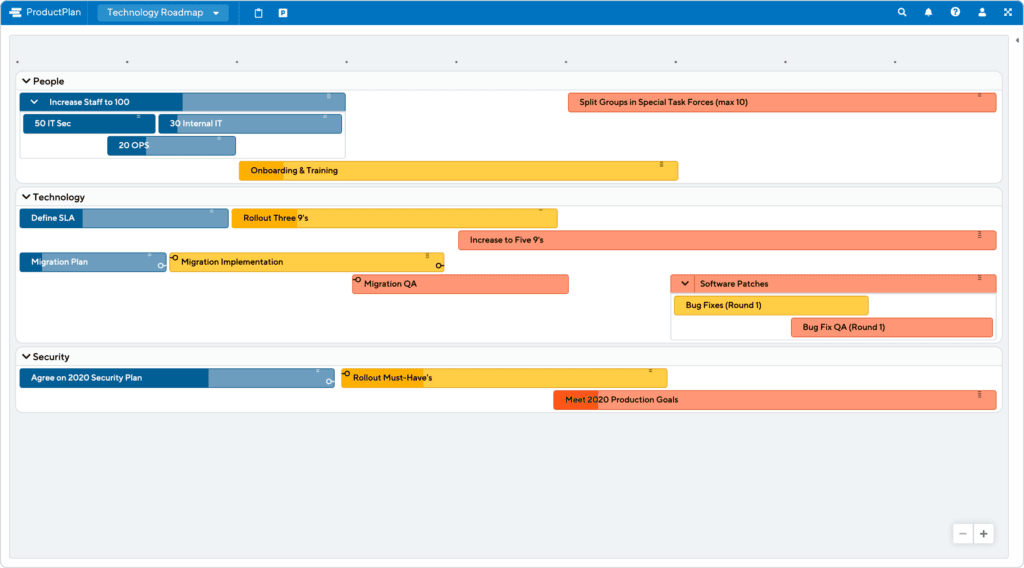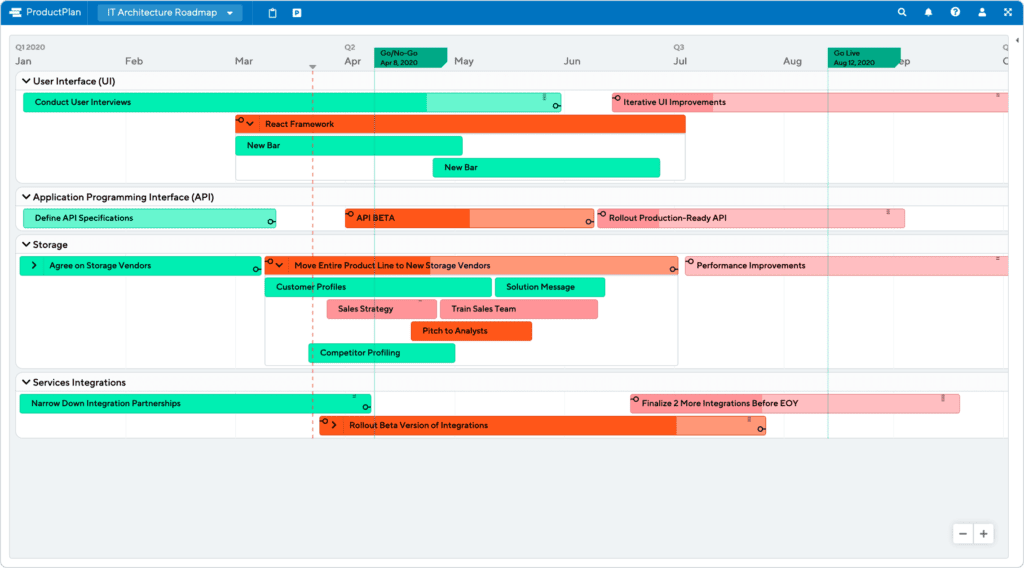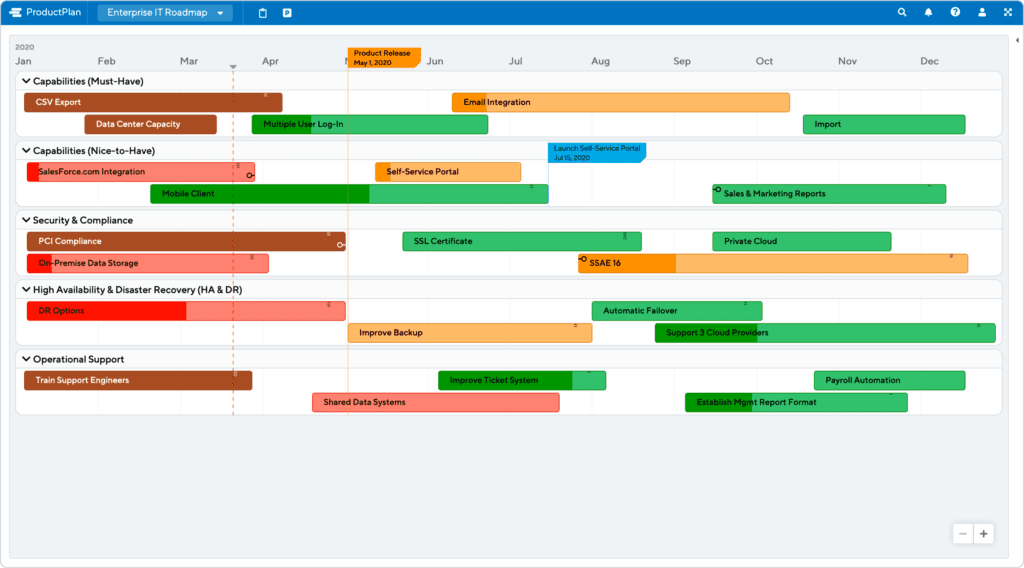What is a technology roadmap?
A technology roadmap is a high-level, visual plan that communicates an organization’s technology strategy. It’s also known as an IT roadmap, technology roadmaps help internal teams make strategic decisions around their technical infrastructure. There are several kinds of technology roadmaps:
- Internal IT roadmap
- DevOps roadmap
- Infrastructure roadmap
- Architecture Roadmap
- Software Roadmap
- Internal Systems Roadmap
- Hardware Procurement Roadmap
Roadmaps are not just for product managers. Many teams can benefit from a strategic roadmap guiding their work. This includes IT teams using a technology roadmap. Roadmaps can serve many different purposes and be organized in a variety of ways. To spark your inspiration, read on to see the three example ways we’ve created technology roadmaps.
We often associate product roadmaps with the development of products. Additionally, we often associate the creation of roadmaps with product managers. But the two key value propositions of building a product roadmap are integral to the success of any business initiative. Initiatives such as upgrading your company’s technology backbone.
The key value propositions of any roadmap can be summed up this way:
- A roadmap creates a useful strategic framework in which you, as the driver of the initiative, can effectively organize and prioritize your ideas. You can prioritize the objectives and requirements into a high-level strategic plan that will inform all downstream decisions.
- A roadmap also makes it far easier for you to communicate your strategic plan and its details to the various constituents. You will need to earn buy-in and collaborate with these constituents throughout the development process.
This is why developing a roadmap can be an invaluable exercise for any stakeholder launching a complex initiative.
Technology Roadmap Example

You can use a roadmap to plan out strategic technology initiatives in the future. Initiatives like, migrating different software systems or rolling out software updates. Your audience for a technology roadmap will be stakeholders looking to the IT team for delivering internal-facing systems and solutions. The technology roadmap may also be shared with partners and vendors who rely on integrations and other technology from the organization.
In the example illustrated here, the roadmap is divided into three different categories: People, Technology, and Security. The colors indicate the status of each initiative. The roadmap can have a time horizon such as the next year.
A technology roadmap can also be broader in scope. Focus on the creation of new technology entirely instead of deploying existing technology across a company or department.
The key to a successful technology roadmap is its ability to quickly and effectively communicate the strategic plan to the right constituents.
Architecture Technology Roadmap Example
 In many software companies, the software architect is tasked with building a solid foundation that is the backbone of the company’s products. A typical method of creating, communicating and tracking this backbone is with an architecture roadmap. Common architecture roadmap components are the Application Programming Interface (API), User Interface (UI), Storage and third-party services integrations.
In many software companies, the software architect is tasked with building a solid foundation that is the backbone of the company’s products. A typical method of creating, communicating and tracking this backbone is with an architecture roadmap. Common architecture roadmap components are the Application Programming Interface (API), User Interface (UI), Storage and third-party services integrations.
These platform components are often part of other product roadmaps in the organization because features may rely on them.
In Large-Scale Software Architecture: A Practical Guide Using UML, we learned that among a software architect’s key objectives in creating and managing a software architecture roadmap will be:
“To manage the selection of technologies and software products used in the [company’s] current product, and to develop a plan for evolving these technologies as the product evolves.”
And…
“To control the infusion of commercial software products, open-source software, and freeware — taking into account the inherent tradeoffs among these different technologies such as cost, time-to-market and the quality of the solutions.”
In the screenshot example above, the roadmap is color-coded based on project status. There is Planning & Design, Implementation & Testing, Optimization. It’s common that the timeframe for an Architecture Roadmap is long-term.
An important note about your technology roadmap:
Notice that each initiative within this roadmap is discussed only at the strategic level rather than the task level. For example, under the “UI” section of the roadmap one of the components is to “Conduct User Interviews.” This section allows the driver of the initiative to communicate the major phases of the project to the relevant constituents and stakeholders. That way everyone is on the same page in terms of the goals and necessary steps. This roadmap leaves the specific tasks under “Conduct User Interviews” (e.g., culling a list of users, assigning interviews to specific team members, gathering and reporting feedback from those interviews, etc.) to project management.
Enterprise IT Technology Roadmap Example
 It is easy for large enterprises to lose sight of all the important initiatives going on across their IT organizations. An enterprise IT roadmap allows you to visualize your strategic initiatives. The audience of internal stakeholders will be looking to the IT team for delivering internal-facing systems, security, and other solutions.
It is easy for large enterprises to lose sight of all the important initiatives going on across their IT organizations. An enterprise IT roadmap allows you to visualize your strategic initiatives. The audience of internal stakeholders will be looking to the IT team for delivering internal-facing systems, security, and other solutions.
In a recent CIO Magazine article, “Why You Need a Strategic IT Roadmap,” Steve Ronan explains that as the role of organizations’ technology leaders moves from operational to strategic, these leaders increasingly need an IT roadmap. He defines as:
“The governing document that dictates specifically how technology will support the business strategy and help business priorities.”
In the screenshot example, the roadmap outlines capabilities based on their strategic importance. Grouping them by security and compliance initiatives, High Availability & Disaster Recovery (HA & DR), as well as operational support tasks. The timeframe for these strategic roadmaps is longer, often 12-18 months.
This longer timeframe is often necessary. This is because the individual components of many enterprises IT initiatives require longer lead time — for example, the “Train Support Engineers” component in the Operational Support category.
Discover Even More Technology Roadmap Template Examples
Businesses use our product roadmap software to create thousands of roadmaps in virtually every industry. From marketing roadmaps to executive-facing roadmaps, IT roadmaps, sprint roadmaps, and a wide variety of technology roadmaps. Visit our Roadmap Templates Page to see many more examples and to gain ideas and inspiration for your next roadmap.




